Abstract
Miller-Dieker syndrome (MDS), a disorder manifesting the severe brain malformation lissencephaly ("smooth brain"), is caused, in the majority of cases, by a chromosomal microdeletion of the distal short arm of chromosome 17. Using human chromosome 17-specific DNA probes, we have begun a molecular dissection of the critical region for MDS. To localize cloned DNA sequences to the MDS critical region, a human-rodent somatic cell hybrid panel was constructed which includes hybrids containing the abnormal chromosome 17 from three MDS patients with deletions of various sizes. Three genes (myosin heavy chain 2, tumor antigen p53, and RNA polymerase II) previously mapped to 17p were excluded from the MDS deletion region and therefore are unlikely to play a role in its pathogenesis. In contrast, three highly polymorphic anonymous probes, YNZ22.1 (D17S5), YNH37.3 (D17S28), and 144-D6 (D17S34), were deleted in each of four patients with visible deletions, including one with a ring chromosome 17 that is deleted for a portion of the single telomeric prometaphase subband p13.3. In two MDS patients with normal chromosomes, a combination of somatic cell hybrid, RFLP, and densitometric studies demonstrated deletion for YNZ22.1 and YNH37.3 in the paternally derived 17's of both patients, one of whom is also deleted for 144-D6. The results indicate that MDS can be caused by submicroscopic deletion and raises the possibility that all MDS patients will prove to have deletions at a molecular level. The two probes lie within a critical region of less than 3,000 kb and constitute potential starting points in the isolation of genes implicated in the severe brain maldevelopment in MDS.
Full text
PDF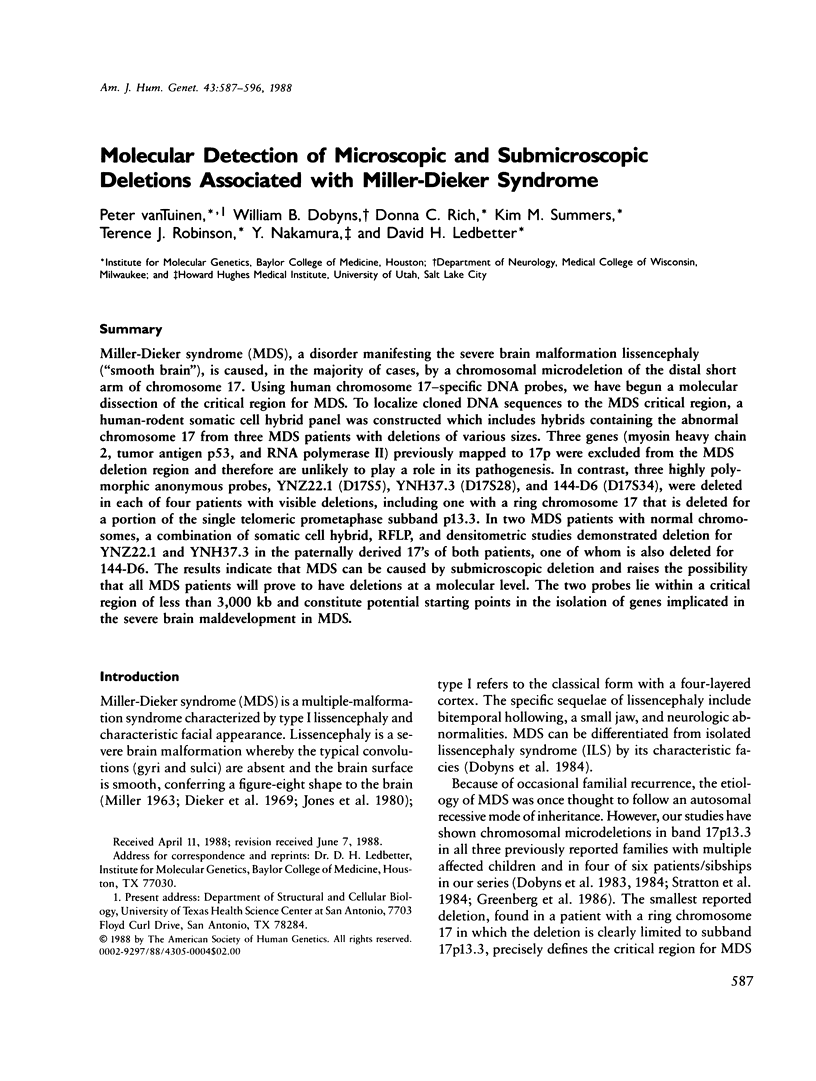
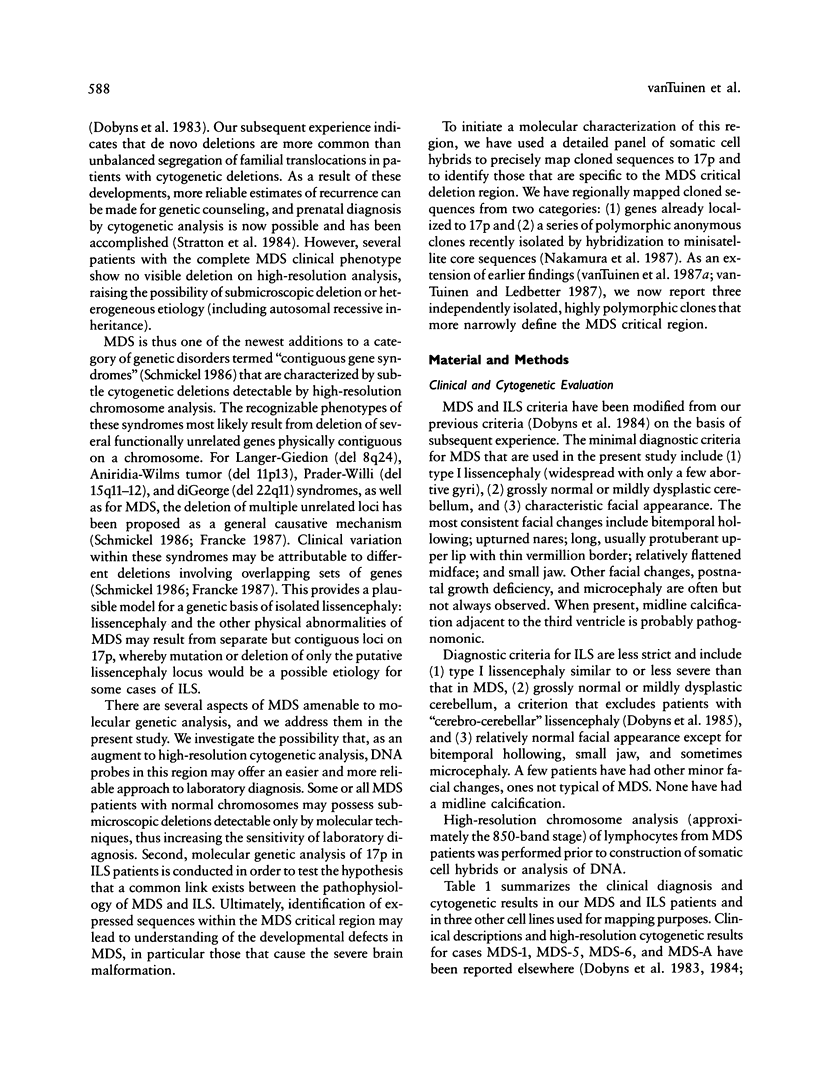
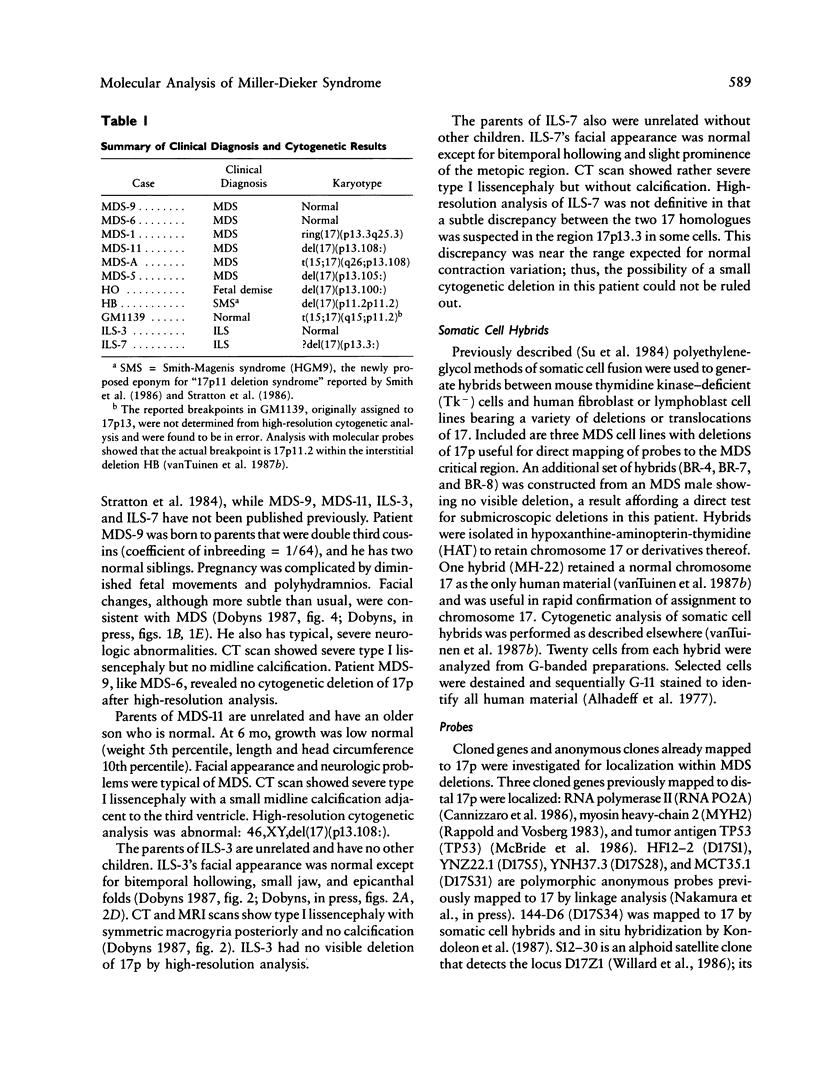
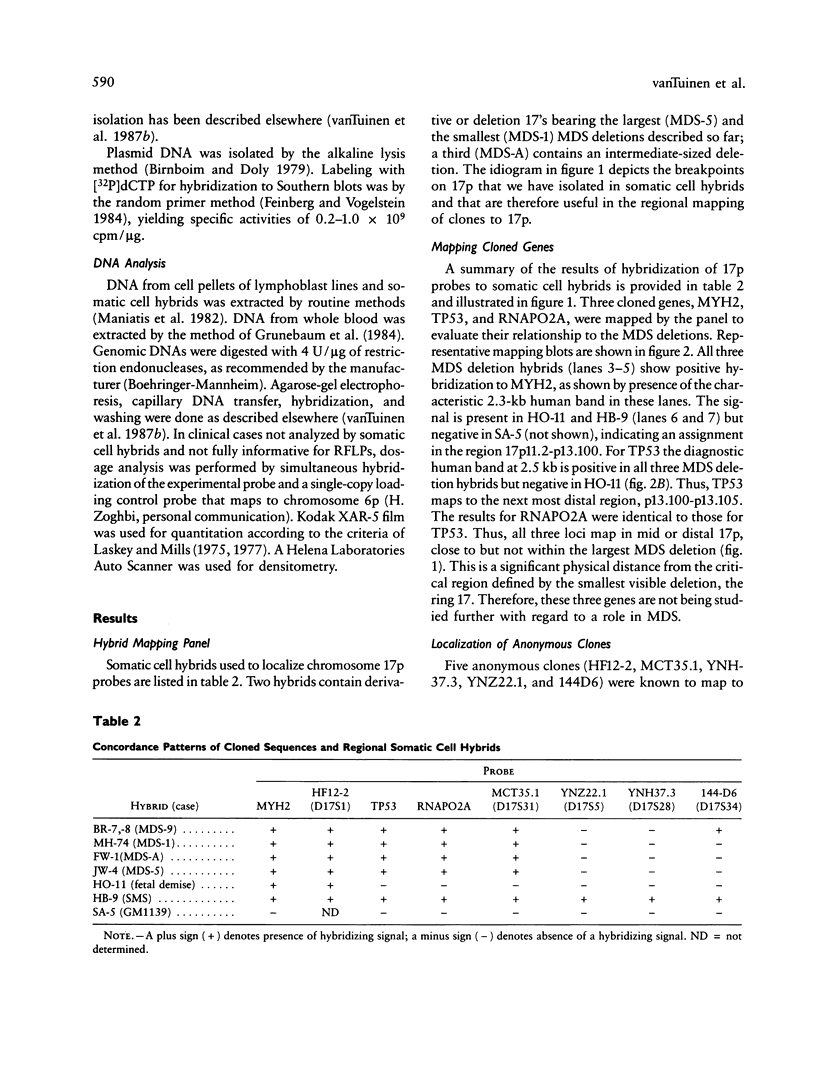
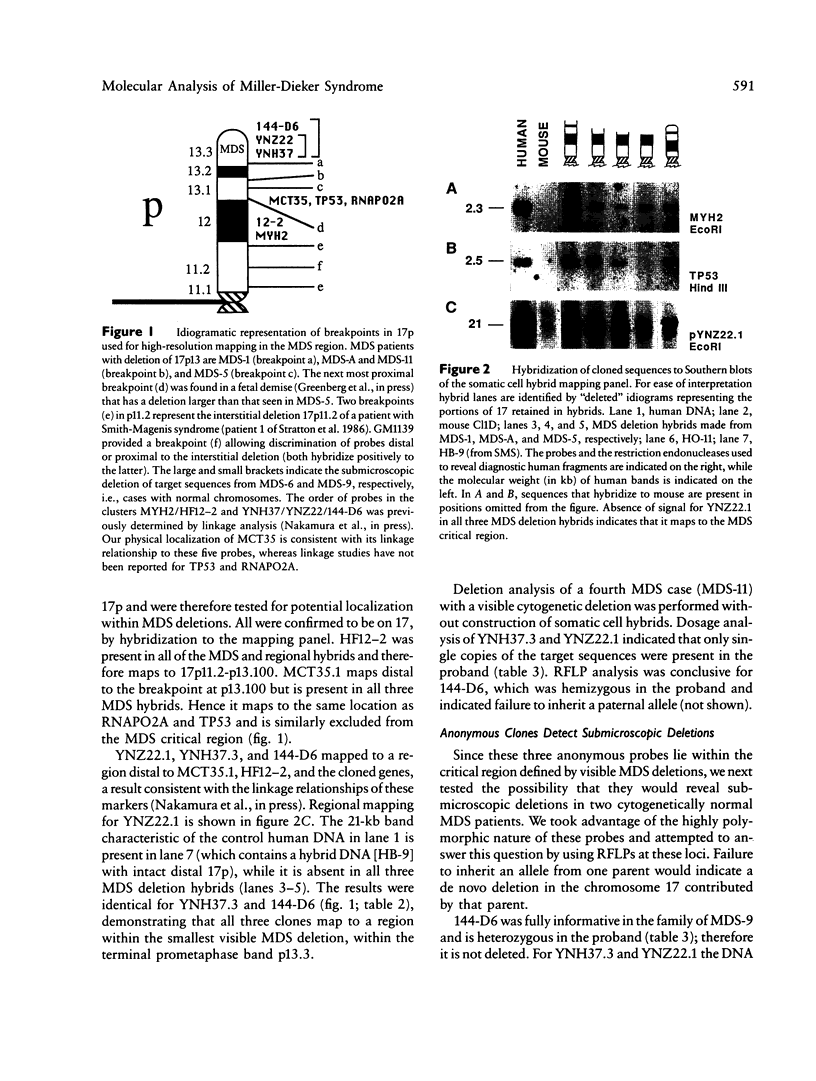
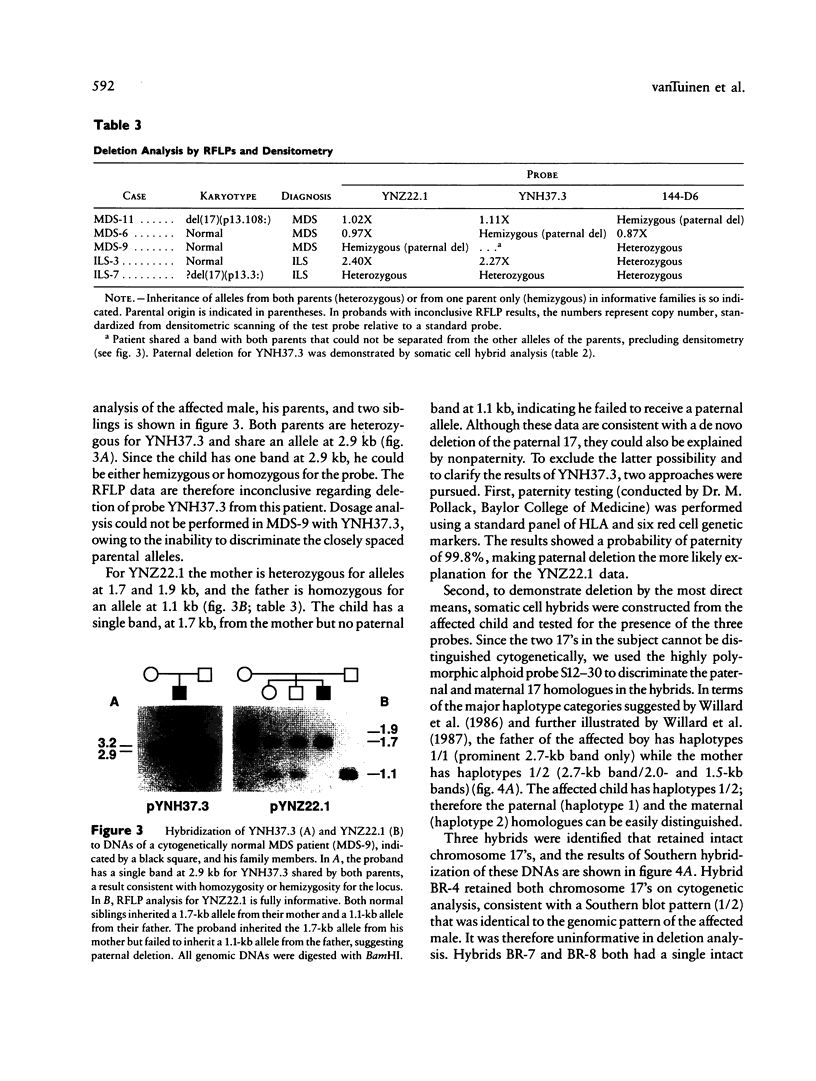

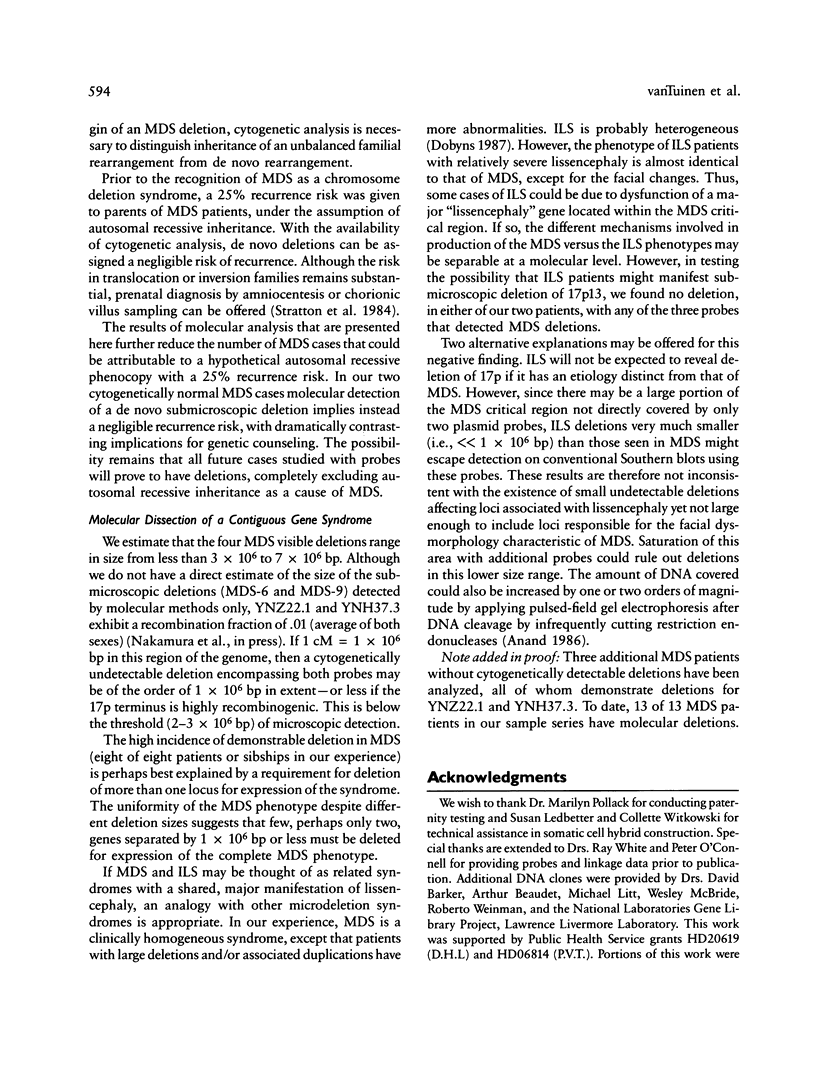
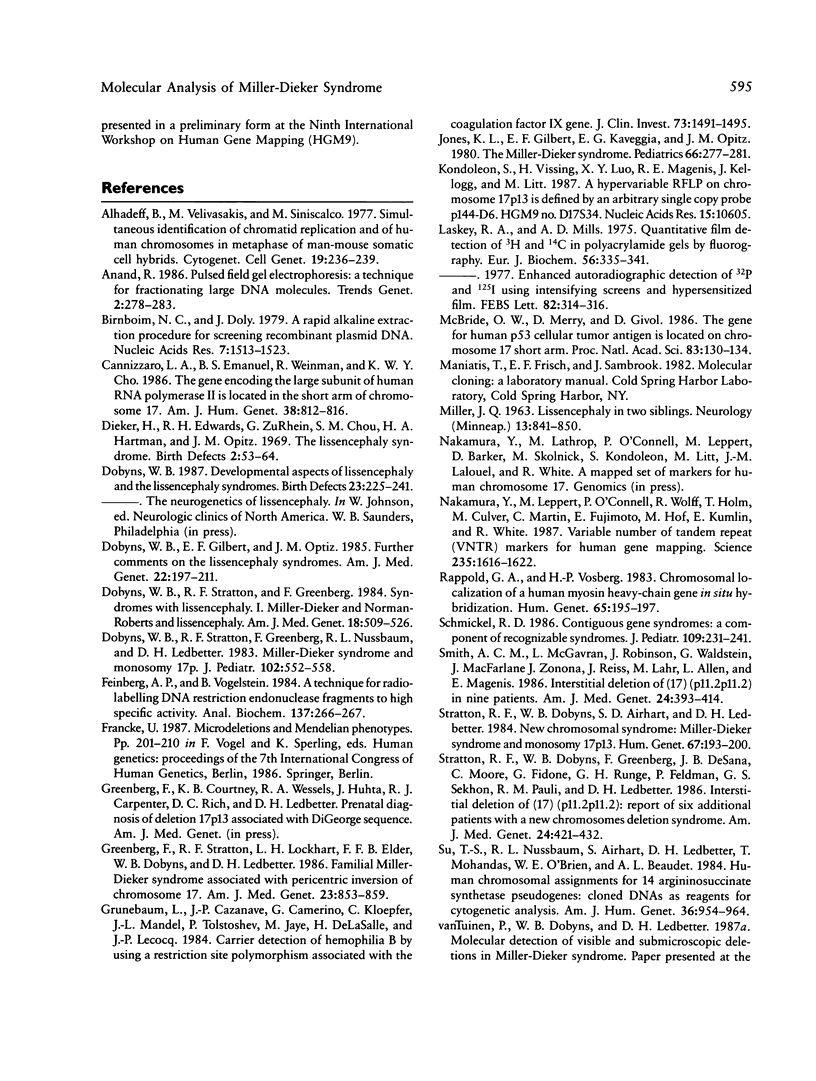
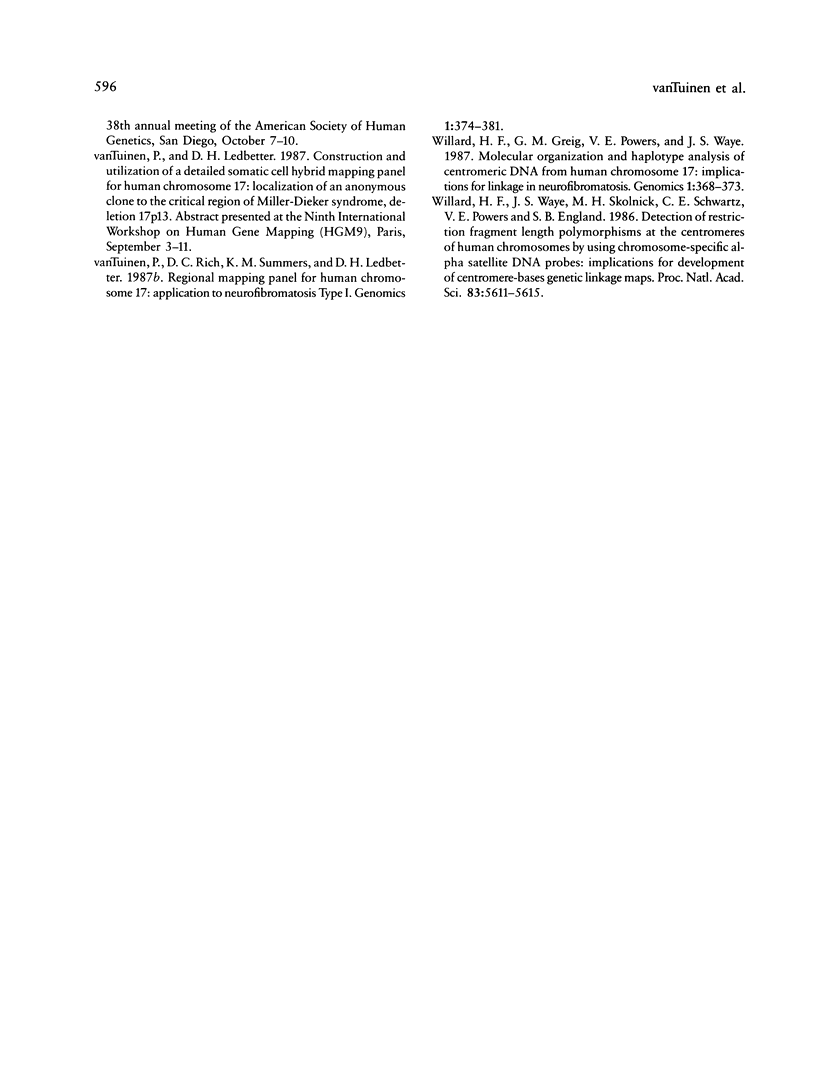
Images in this article
Selected References
These references are in PubMed. This may not be the complete list of references from this article.
- Alhadeff B., Velivasakis M., Siniscalco M. Simultaneous identification of chromatid replication and of human chromosomes in metaphases of man-mouse somatic cell hybrids. (With 1 color plate). Cytogenet Cell Genet. 1977;19(4):236–239. doi: 10.1159/000130814. [DOI] [PubMed] [Google Scholar]
- Birnboim H. C., Doly J. A rapid alkaline extraction procedure for screening recombinant plasmid DNA. Nucleic Acids Res. 1979 Nov 24;7(6):1513–1523. doi: 10.1093/nar/7.6.1513. [DOI] [PMC free article] [PubMed] [Google Scholar]
- Cannizzaro L. A., Emanuel B. S., Cho K. W., Weinmann R. The gene encoding the large subunit of human RNA polymerase II is located on the short arm of chromosome 17. Am J Hum Genet. 1986 Jun;38(6):812–818. [PMC free article] [PubMed] [Google Scholar]
- Dobyns W. B. Developmental aspects of lissencephaly and the lissencephaly syndromes. Birth Defects Orig Artic Ser. 1987;23(1):225–241. [PubMed] [Google Scholar]
- Dobyns W. B., Gilbert E. F., Opitz J. M. Further comments on the lissencephaly syndromes. Am J Med Genet. 1985 Sep;22(1):197–211. doi: 10.1002/ajmg.1320220119. [DOI] [PubMed] [Google Scholar]
- Dobyns W. B., Stratton R. F., Greenberg F. Syndromes with lissencephaly. I: Miller-Dieker and Norman-Roberts syndromes and isolated lissencephaly. Am J Med Genet. 1984 Jul;18(3):509–526. doi: 10.1002/ajmg.1320180320. [DOI] [PubMed] [Google Scholar]
- Dobyns W. B., Stratton R. F., Parke J. T., Greenberg F., Nussbaum R. L., Ledbetter D. H. Miller-Dieker syndrome: lissencephaly and monosomy 17p. J Pediatr. 1983 Apr;102(4):552–558. doi: 10.1016/s0022-3476(83)80183-8. [DOI] [PubMed] [Google Scholar]
- Feinberg A. P., Vogelstein B. "A technique for radiolabeling DNA restriction endonuclease fragments to high specific activity". Addendum. Anal Biochem. 1984 Feb;137(1):266–267. doi: 10.1016/0003-2697(84)90381-6. [DOI] [PubMed] [Google Scholar]
- Greenberg F., Stratton R. F., Lockhart L. H., Elder F. F., Dobyns W. B., Ledbetter D. H. Familial Miller-Dieker syndrome associated with pericentric inversion of chromosome 17. Am J Med Genet. 1986 Apr;23(4):853–859. doi: 10.1002/ajmg.1320230402. [DOI] [PubMed] [Google Scholar]
- Grunebaum L., Cazenave J. P., Camerino G., Kloepfer C., Mandel J. L., Tolstoshev P., Jaye M., De la Salle H., Lecocq J. P. Carrier detection of Hemophilia B by using a restriction site polymorphism associated with the coagulation Factor IX gene. J Clin Invest. 1984 May;73(5):1491–1495. doi: 10.1172/JCI111354. [DOI] [PMC free article] [PubMed] [Google Scholar]
- Jones K. L., Gilbert E. F., Kaveggia E. G., Opitz J. M. The MIller-Dieker syndrome. Pediatrics. 1980 Aug;66(2):277–281. [PubMed] [Google Scholar]
- Kondoleon S., Vissing H., Luo X. Y., Magenis R. E., Kellogg J., Litt M. A hypervariable RFLP on chromosome 17p13 is defined by an arbitrary single copy probe p144-D6 [HGM9 No. D17S34]. Nucleic Acids Res. 1987 Dec 23;15(24):10605–10605. doi: 10.1093/nar/15.24.10605. [DOI] [PMC free article] [PubMed] [Google Scholar]
- Laskey R. A., Mills A. D. Quantitative film detection of 3H and 14C in polyacrylamide gels by fluorography. Eur J Biochem. 1975 Aug 15;56(2):335–341. doi: 10.1111/j.1432-1033.1975.tb02238.x. [DOI] [PubMed] [Google Scholar]
- MILLER J. Q. LISSENCEPHALY IN 2 SIBLINGS. Neurology. 1963 Oct;13:841–850. doi: 10.1212/wnl.13.10.841. [DOI] [PubMed] [Google Scholar]
- McBride O. W., Merry D., Givol D. The gene for human p53 cellular tumor antigen is located on chromosome 17 short arm (17p13). Proc Natl Acad Sci U S A. 1986 Jan;83(1):130–134. doi: 10.1073/pnas.83.1.130. [DOI] [PMC free article] [PubMed] [Google Scholar]
- Nakamura Y., Leppert M., O'Connell P., Wolff R., Holm T., Culver M., Martin C., Fujimoto E., Hoff M., Kumlin E. Variable number of tandem repeat (VNTR) markers for human gene mapping. Science. 1987 Mar 27;235(4796):1616–1622. doi: 10.1126/science.3029872. [DOI] [PubMed] [Google Scholar]
- Rappold G. A., Vosberg H. P. Chromosomal localization of a human myosin heavy-chain gene by in situ hybridization. Hum Genet. 1983;65(2):195–197. doi: 10.1007/BF00286663. [DOI] [PubMed] [Google Scholar]
- Schmickel R. D. Contiguous gene syndromes: a component of recognizable syndromes. J Pediatr. 1986 Aug;109(2):231–241. doi: 10.1016/s0022-3476(86)80377-8. [DOI] [PubMed] [Google Scholar]
- Smith A. C., McGavran L., Robinson J., Waldstein G., Macfarlane J., Zonona J., Reiss J., Lahr M., Allen L., Magenis E. Interstitial deletion of (17)(p11.2p11.2) in nine patients. Am J Med Genet. 1986 Jul;24(3):393–414. doi: 10.1002/ajmg.1320240303. [DOI] [PubMed] [Google Scholar]
- Stratton R. F., Dobyns W. B., Airhart S. D., Ledbetter D. H. New chromosomal syndrome: Miller-Dieker syndrome and monosomy 17p13. Hum Genet. 1984;67(2):193–200. doi: 10.1007/BF00273000. [DOI] [PubMed] [Google Scholar]
- Stratton R. F., Dobyns W. B., Greenberg F., DeSana J. B., Moore C., Fidone G., Runge G. H., Feldman P., Sekhon G. S., Pauli R. M. Interstitial deletion of (17)(p11.2p11.2): report of six additional patients with a new chromosome deletion syndrome. Am J Med Genet. 1986 Jul;24(3):421–432. doi: 10.1002/ajmg.1320240305. [DOI] [PubMed] [Google Scholar]
- Su T. S., Nussbaum R. L., Airhart S., Ledbetter D. H., Mohandas T., O'Brien W. E., Beaudet A. L. Human chromosomal assignments for 14 argininosuccinate synthetase pseudogenes: cloned DNAs as reagents for cytogenetic analysis. Am J Hum Genet. 1984 Sep;36(5):954–964. [PMC free article] [PubMed] [Google Scholar]
- Willard H. F., Greig G. M., Powers V. E., Waye J. S. Molecular organization and haplotype analysis of centromeric DNA from human chromosome 17: implications for linkage in neurofibromatosis. Genomics. 1987 Dec;1(4):368–373. doi: 10.1016/0888-7543(87)90041-3. [DOI] [PubMed] [Google Scholar]
- Willard H. F., Waye J. S., Skolnick M. H., Schwartz C. E., Powers V. E., England S. B. Detection of restriction fragment length polymorphisms at the centromeres of human chromosomes by using chromosome-specific alpha satellite DNA probes: implications for development of centromere-based genetic linkage maps. Proc Natl Acad Sci U S A. 1986 Aug;83(15):5611–5615. doi: 10.1073/pnas.83.15.5611. [DOI] [PMC free article] [PubMed] [Google Scholar]
- van Tuinen P., Rich D. C., Summers K. M., Ledbetter D. H. Regional mapping panel for human chromosome 17: application to neurofibromatosis type 1. Genomics. 1987 Dec;1(4):374–381. doi: 10.1016/0888-7543(87)90042-5. [DOI] [PubMed] [Google Scholar]





